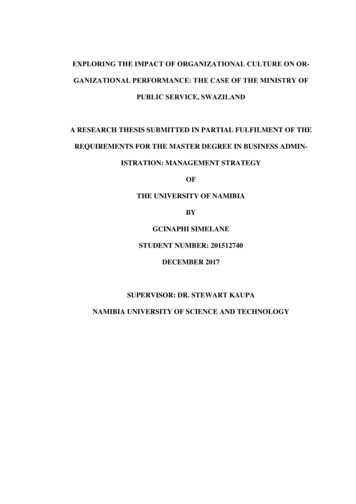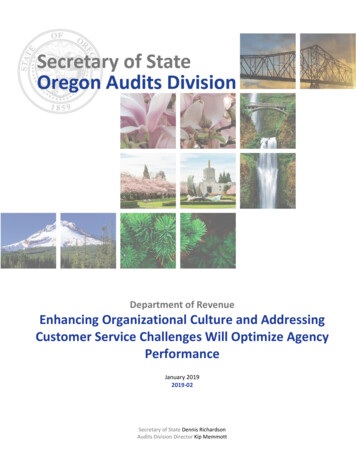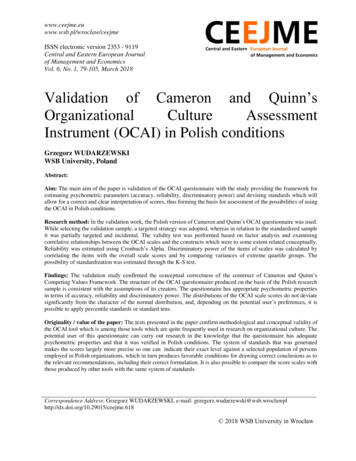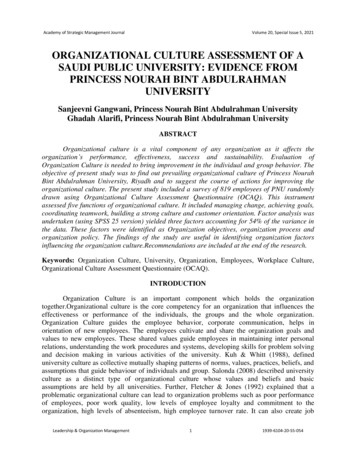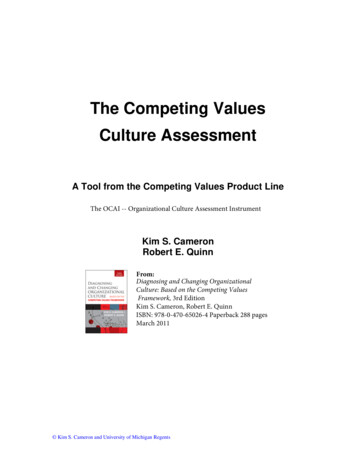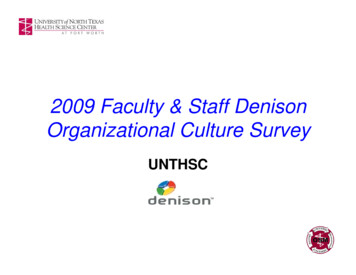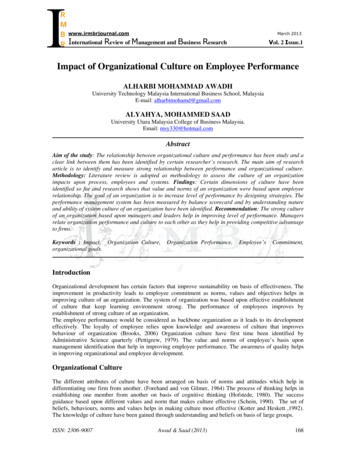
Transcription
Internationaleview ofanagement andusinessesearchol. 2 ssue.1Impact of Organizational Culture on Employee PerformanceALHARBI MOHAMMAD AWADHUniversity Technology Malaysia International Business School, MalaysiaE-mail: alharbimohamd@gmail.comALYAHYA, MOHAMMED SAADUniversity Utara Malaysia College of Business Malaysia.Email: msy330@hotmail.comAbstractAim of the study: The relationship between organizational culture and performance has been study and aclear link between them has been identified by certain researcher’s research. The main aim of researcharticle is to identify and measure strong relationship between performance and organizational culture.Methodology: Literature review is adopted as methodology to assess the culture of an organizationimpacts upon process, employees and systems. Findings: Certain dimensions of culture have beenidentified so far and research shows that value and norms of an organization were based upon employeerelationship. The goal of an organization is to increase level of performance by designing strategies. Theperformance management system has been measured by balance scorecard and by understanding natureand ability of system culture of an organization have been identified. Recommendation: The strong cultureof an organization based upon managers and leaders help in improving level of performance. Managersrelate organization performance and culture to each other as they help in providing competitive advantageto firms.Keywords0:0Impact, Organization0Culture,organizational ent,IntroductionOrganizational development has certain factors that improve sustainability on basis of effectiveness. Theimprovement in productivity leads to employee commitment as norms, values and objectives helps inimproving culture of an organization. The system of organization was based upon effective establishmentof culture that keep learning environment strong. The performance of employees improves byestablishment of strong culture of an organization.The employee performance would be considered as backbone organization as it leads to its developmenteffectively. The loyalty of employee relies upon knowledge and awareness of culture that improvesbehaviour of organization (Brooks, 2006) Organization culture have first time been identified byAdministrative Science quarterly (Pettigrew, 1979). The value and norms of employee’s basis uponmanagement identification that help in improving employee performance. The awareness of quality helpsin improving organizational and employee development.Organizational CultureThe different attributes of culture have been arranged on basis of norms and attitudes which help indifferentiating one firm from another. (Forehand and von Gilmer, 1964) The process of thinking helps inestablishing one member from another on basis of cognitive thinking (Hofstede, 1980). The successguidance based upon different values and norm that makes culture effective (Schein, 1990). The set ofbeliefs, behaviours, norms and values helps in making culture most effective (Kotter and Heskett ,1992).The knowledge of culture have been gained through understanding and beliefs on basis of large groups.ISSN: 2306-9007Awad & Saad (2013)168
Internationaleview ofanagement andusinessesearchol. 2 ssue.1Culture is defined as a mixture of values, sets, beliefs, communications and explanation of behaviour thatprovides guidance to people.The main idea of culture comes from sharing in learning processes that have been based upon systematicallocation of resources. (Titiev, 1959) The cognitive systems of human that helps in improving thinking anddecision making were based upon organization culture. (Pettigrew 1979) The multifaceted set of beliefs,assumptions and values helps in presenting different level of culture by conducting business at an effectivemanner. The normative glue based upon organization culture helps in holding overall managementeffectiveness.( Tichy 1982). The concept of effective organization culture helps in improving businessdecisions. The survival of culture in an organization lies upon national and foreign culture differentiation inculture management. (Schein, 1990) The culture of organization has been affected by attitudes, norms andbeliefs that lead to strong communication between employees.Now a day’s organization culture has generally been interrelated to management. (Kotter and Heskett,1992).The two essential factors that lead to effective culture management include structural stability andintegration of superior standard of organization culture. (Schein, 1995) Certain characteristics oforganization culture have been established in which set of norms, values and beliefs helps in perfectassociation between them. (Hodgetts and Luthans, 2003) At different level of organization culture differentbackground, ethics and racial differences impact upon performance. The similar organization culture withdifferent backgrounds has common set of values and beliefs to be effected by organization systems.(Robbins & Sanghi, 2007) The attraction of organization norms, values and beliefs have strong affect uponperformance and sustainability. (Stewart, 2010) The norms of employees impact upon sustainableperformance and management of organization culture as it leads to attainment of profitability. Differentkinds of cultures have been defined as followed:Counter CultureThe values and beliefs of organization culture which were shared among different managementdepartments and managers were forced to gain advantage from them come under countercultures. (Kerr, J.,& Slocum, J. W., Jr. 2005) The organization performance based upon contribution of strong culture leads tostrong association between performance and management.Sub CultureSubcultures have been defined as organization segments with different sets of norms, values and beliefs onbasis of geographical areas, job requirements and department goals.(Schein,1995) The commitment ofemployees towards organization basis upon employee perception that affects upon culture . (Lok,Westwood and Crawford, 2005) The social interaction of workplace outside organization considers well forsome groups.Strong CultureThe same type of values and beliefs which an employee holds in culture must be considered strong. Thebeliefs and values of organization were considered strong when employee embraces greater part of culture.(Deal and Kennedy, 1982) The reduction in gaps on employee relationship has been agreed with managersso far. The rules in organization must be considered important for employees. The policies, procedures andobjectives designed by top managers must influence upon behaviour of employees so that competitiveadvantage have been gainedWeak CultureThe loosely knit organization cultures that helps in pushing thought, attitudes and beliefs of individuals tobe more innovative. The valuable asset contributes to growing needs and wants of culture management.ISSN: 2306-9007Awad & Saad (2013)169
Internationaleview ofanagement andusinessesearchol. 2 ssue.1The loosely joined culture based upon values and beliefs have association with perfect sets. (Deal andKenndy 1982) The diversity between personal objectives and organizational goals has creativemanagement of rules and procedures so that perfect association have been created between them.Dimension of Organizational CultureIn order to elaborate findings IBM employees were gathered from more than 50 countries so thatorganization culture on basis of dimensions would be perfectly analyzed. (Hofstede’s ,1980) The fourdimensions of organization culture were as followed:Power distance: It is defined as degree of employee and management behaviour that have been based uponperfect relationship between formal and informal set of planning action.Individualism: In this dimension difference between organization interest and self interest have perfectlybeen matched.Uncertainty avoidance: The uncertainty and ambiguity based upon tolerance helps in mitigatingwillingness of people.Masculinity: It comes in avoidance of caring and promotion rather than level of success based uponchallenges, insolence and ambition.In 1998 Hofstede and Bond identified fifth dimension in which 23 countries long and short term orientationhave perfectly been analyzed. The organizational behaviour relates to practitioners values and beliefs basedupon culture factors and norms that effects upon personality and performance of organization.(Sondergaard, 1994) The cultural factors and personality impacts upon behaviour and sustainability oforganization (Schwartz,1994) The models developed by Hofstede in 1980 presents 38 countries studies inwhich strong relationships of culture have been identified.From these classifications two different kind of dimensions have been identified such as : Affective &intellectual while secondly self enhancement and self transcendence . The standards based upon culturesand societies present contractual relationship between life and work. The standards based upon culturalassociation leads to perfect association between performance and management. More than 30 companiesfrom 50 different countries have been identified (Trompanaars 1993) . Seven different dimensions ofcultures have also been identified such as universalism versus particularize, specific versus diffuse,emotional versus neutral, communication versus individualism, achievement versus ascription, attitude toenvironment and attitude to time. The Hofstede’s model has seven dimensions that help in presentingeffective relationship between different sets of norms and values.Organizational PerformanceThe degree of an achievement to which an employee’s fulfill the organizational mission at workplace iscalled performance (Cascio, 2006). Performance has been perceived differently by various researchers, butmost of the scholars relate performance with measurement of transactional0efficency and effectivenesstowards organizational goals (Stannack, 1996; Barne, 1991).The job of an employee is build up by degree of achievement of a particular target or mission that definesboundaries of performance (Cascio, 2006). Certain researchers have identified different thought, attitudesand beliefs of performance as it helps in measurement of input and output efficiency measures that lead totransactional association. (Stannack, 1996)The capability of an organization to establish perfect relationship with resources presents effective andefficient management of resources. (Daft, 2000) In order to achieve goals and objectives of organizationstrategies have been designed based upon organizational performance. (Richardo, 2001) The equity basedupon high returns helps in effective management of organization resources so that performance improves.(Ricardo, 2001)ISSN: 2306-9007Awad & Saad (2013)170
Internationaleview ofanagement andusinessesearchol. 2 ssue.1The performance measurement system helps in improving organization association to achieve goals andobjectives at an effective manner. (Ittner and Larcker, 1998) The strategic planning based upondevelopment of goals and objectives help organization to focus non-financial or intangible assets. Thequality, performance and services linked with customers have financial nature (Kaplan and Norton, 2001).The financial and non financial reward management systems enabled by measurement and evaluation ofperformance measurement system.The traditional measurement of performance based upon strategic performance system. The translation andmeasurement of financial and non financial performance based upon SPMS leads to competitiveness(Chenhall, 2005). The measurement technique helps in increasing competitive advantage in organizationbased upon effective pressures. The multiple performance measures adopted by organization based uponnon financial and financial measures helps in presenting uncontrollable events (Burns and McKinnon,1993). The measurement technique adopted by organization helps in presenting positive association ofgoods and services.The Balance Score card have been used to evaluate performance management of employees based uponperfect association between goods and services.( Kaplan and Norton ,1992) The strategies based uponrationality and design helps in making culture more effective. The four casual relationships betweenperformance management and culture have been defined so far. The learning growth, customers, internalbusiness process and financial reward management system helps in improving and presenting casualrelationship. The focus of an organization for cooperative tool helps in improving communication amongbusiness performance. The organizational goals and strategies based upon feedback helps in improvingperformance management.Linkage of Organizational culture with Organizational performanceDenison (1984) studied 34 Americans cultural performance on basis of characteristics that helps inimproving performance over time. The culture and performance have been interrelated to each other basedupon perfect association between business processes (Reichers and Schneider, 1990). The culture constructbased upon operational complexity have its basis towards different business processes. In more than 200organizations economic and long term performance have been investigated (Kotter and Heskett ,1992).Several researches have been made to evaluate performance of organization based upon efforts as culturehas been given significant association. The three contributions on culture defined were as followed:Organizational CulturePower rtaintyAvoidanceMasculinityFig. 1 Research FrameworkISSN: 2306-9007Awad & Saad (2013)171
Internationaleview ofanagement andusinessesearchol. 2 ssue.1Firstly culture and performance were considered interrelated to each other by forceful management.Secondly nature and scope of culture based upon theoretical point of view have been presented moreappropriately. While strong association between management practices, performance and culturemanagement have been presented so that culture establishment takes place effectively.The competitive advantage of an organization is attained through strong association and establishment ofculture. The organization culture helps in measuring limitation to overcome performance measurement.(Rousseau 1990) The limitations shows that culture and employee performance shows negative correlationas employee performance is badly affected by it.The methodologies and findings of researches shows that culture and performance were consideredinterrelated. (Lim, 1995) The sustainable competitive advantage of organizational competencies has beenrelated to superior and imitable relationship with0competitors0 (Saa-Pe’re and Garcia-Falcon, 2002). Thevalue of culture based upon degree of performance has been managed with practitioners and academics.(Denison, 1990)ConclusionThe different values and beliefs based upon employee performance helps in organization association. Theorganization culture helps in internalizing joint relationship that leads to manage effective organizationprocesses. The productivity and culture of organization helps in improving performance. In more than 60research studies 7600 small business units and companies’ performance from 1999 to 2007 have beenevaluated. The positive association between culture and performance helps in improving results oforganization.The job performance of organization has a strong impact of strong organization culture as it leads toenhance productivity. The norms and values of organization based upon different cultures influence onwork force management. In an organization strong culture enables to effective and efficient management ofwork force employees. The net profit in an organization helps in enhancing performance of employees. Thecommon path for making perfect use of resources in same cultural association helps in positivedevelopment of organization. On basis of particular conditions organizational culture is helpful inimproving and providing competitive edge. The employee commitment and group efficiency helps inimproving performance based upon organization sustainability. The nature and power of organizationculture influence upon sustainability and effective of organization.ReferencesAlvesson, M. (1989), Concepts of organizational culture and presumed links to efficiency. InternationalJournal of Management Science, 17(4), 323-33Barney, J.B. (1991). Firm Resources and Sustained Competitive Advantage. Journal of Management, 1(17): 99-120Brooks, I. (2006). Organizational Behavior: Individuals, Groups and Organization. Essex: PearsonEducation Limited.Burns, W.J. and McKinnon, S.M. (1993). Information and Managers: a Field Study. Journal ofManagement Accounting Research, 5, 84-123Cascio, W. F. (2006). Managing Human Resources: Productivity, Quality of Life, Profits. McGraw-HillIrwin.ISSN: 2306-9007Awad & Saad (2013)172
Internationaleview ofanagement andusinessesearchol. 2 ssue.1Chenhall, R.H. (2005). Integrative Strategic Performance Measurement System, Strategic Alignment ofManufacturing, Learning and Strategic outcomes: an exploratory study. Accounting, Organizationsand Society, 30(5), 395-422.Churchill, G.A. (1999). Marketing Research: Methodological Foundations. The Dryden Press, Forth WorthDaft, R.L.(2000). Organization Theory and Design. (7th Ed.) South-Western College Publishing, ThomsonLearning. U.S.A.Dasanayake, S. W. S. B and Mahakalanda, I. (2008). A Literature Survey on Organizational Culture andInnovation. Global Business and Management Research, Boca Raton, Florida539-550Denison, D.R. (1984). Bringing corporate culture to the bottom line. Organizational Dynamics, 13(2), 5-22.Denison, D.R. (1990). Corporate Culture and Organisational Effectiveness. New York: Wiley.Deal, T.E. and Kennedy, A.A. (1982). Corporate cultures: The Rites and Rituals of Corporate Life.Reading, Mass: Addison-Wesley Publishing Co.Forehand, G. A. and Von Gilmer, (1964). Environmental Variations in Studies of Organizational Behavior.Psychological Bulletin, 62, 361-382.Heffernan, M.M. & Flood, P.C.(2000). An Exploration of the Relationship between ManagerialCompetencies Organizational, Characteristic and Performance in an Irish organization. Journal ofEuropean Industrial Training. University Press, 128-136.Hodgetts and Luthans, F. (2003). International Management: Culture, Strategy, and Behavior. New York,McGraw-Hill/Irwin, Fifth Edition.Hofstede, G. (1980). Culture’s Consequences, Sage London.Hofstede, G. Bond, M. H. (1998). The Confucius Connection: from Cultural Roots to Economic Growth.Organ Dyn, pp. 5-21.Ittner, C.D. and Larcker, D.F. (1998). Innovations in Performance Measurement: trends and researchimplications, Journal of Management Accounting Research, Vol.10, 205-38.Kaplan, R.S. and Norton, D.P. (1996). Linking the balanced scorecard to strategy. CaliforniaManagementReview. 39(1), 53-79.Kaplan, R.S. and Norton, D.P. (2001). The Strategy-focused Organization: How Balanced ScorecardCompanies Thrive in the New Business Environment. Harvard Business School Press, Boston, MA.Kerr, J. & Slocum, J. W. (2005). Managing corporate culture through reward systems. Academy ofManagement Executive, 19, 130–138Kotter, J. P. & Heskett, J. L. (1992). Corporate culture and performance. New York: Free Press.Lim, B. (1995). Examining the organizational culture and organizational performance link. Leadership &Organization Development Journal, 16(5).ISSN: 2306-9007Awad & Saad (2013)173
Internationaleview ofanagement andusinessesearchol. 2 ssue.1Lok, P. Westwood, R. & Crawford, J. (2005). Perceptions of organizational subculture and theirsignificance for organizational commitment. Applied Psychology: An International Review, 54, 490–514.Ojo, Olu (2003). Fundamentals of Research Methods, Lagos: Standard Publications.Pettigrew, A. (1979). Studying organizational culture. Administrative Science Quarterly, 24, 570-581.Ricardo, R., & Wade, D. (2001). Corporate Performance Management: How to Build a Better Organizationthrough Measurement Driven Strategies Alignment. Butterworth Heinemann.Reichers, A. and Schneider, B. (1990). Climate and culture: an evolution of constructs, in Schneider, B.(Ed.), Organizational Climate and Culture. Jossey-Bass, San Francisco, CA, 5-39.Robbins, S. P. and Sanghi, S. (2007). Organizational Behavior, Pearson Education, New Delhi.Roskin, R. (1986). Corporate culture revolution: the management development imperative. Journal ofManagerial Psychology, 1(2), 3-9.Rousseau, D. (1991). Quantitative assessment of organizational culture. Group and Organizations Studies,15(4), 448-460.Saa-Pere, Petra De and Garcia-Falcon, Juan Manuel (2002). A resource-based view of human resourcemanagement and organizational capabilities development. Int. Journal of Human ResourceManagement, 13(1), 123-140.Saffold, G.S. (1998). Culture Traits, Strength, and Organizational Performance: Movingbeyond StrongCulture. The Academy of Management Review, Vol. 13, 546-558Schein, E. H. (1990). Organizational culture. American Psychologist, 43 (2), 109-119.Schein, E. H. (1995). Organizational culture. Campus Verlag, Frankfurt/New YorkSchein, E.H. (1997). Organizational learning: what is new? Available at: http://learning.mit.edu (accessedApril, 2012).Schwartz S.H. (1994). Beyond Individualism/ Collectivism: New Cultural Dimensions of Values. ThousandOaks, CA: Sage Publication.Sondergaard, M. (1994). Hofstede Consequences- A Study of Reviews, Citations and Replications, SpecialIssue on Cross-national Organization Culture. European Group for Organizational Studies, 15(3): 447456.Stannack, P. (1996). Perspective on Employees Performance. Management Research News, l19(4/5), n/v/index.jsp?vgnextoid ab411f07760aa110VgnVCM1000004b0d1872 RCRD&vgnextfmt default on April, 23, 2012Strauss, A.L. and Corbin, J. (1990). Basics of Qualitative Research: Grounded Theory Procedures andTechniques, Sage, London.ISSN: 2306-9007Awad & Saad (2013)174
Internationaleview ofanagement andusinessesearchol. 2 ssue.1Tichy, N. M. (1982). Managing Change Strategically: The Technical, Political, and Cultural Keys.Organizational Dynamics (autumn), pp. 59-80.Titiev, M. (1959). Introduction to Cultural Anthropology. New York: Henry Holt & Company.Trompanaar F. (1993). Riding the Waves of Culture. London: Economist BooksISSN: 2306-9007Awad & Saad (2013)175
business performance. The organizational goals and strategies based upon feedback helps in improving performance management. Linkage of Organizational culture with Organizational performance Denison (1984) studied 34 Americans cultural performance on basis of characteristics that helps in improving performance over time.
